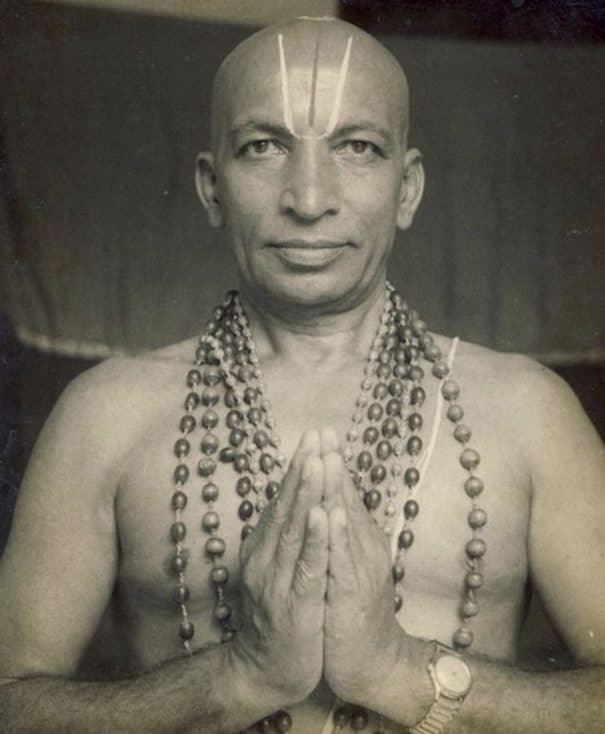AṢṬĀṄGA YOGA
WHAT IS AṢṬĀṄGA YOGA?
Aṣṭāṅga Yoga (also called Raja Yoga) is a well-known Hatha Yoga system that has its roots in Patanjali’s Sutras and Yoga Korunta. The oldest known Aṣṭāṅga yoga teacher is Sri T. Krishnamacharya, who in turn passed on his knowledge to his yoga students, including T.K.V. Desikachar, B.K.S. Iyengar and K. Pattabhi Jois.
In the practice of Ashtanga Yoga, we switch dynamically and in harmony with breathing between different postures (asanas) and thus work energetically with our body. But if we look at Aṣṭāṅga Yoga as a whole, then it is much more than what we see on the mat: Translated, it is “the eight-limbed path” and consists of just as many building blocks that are partly visible, partly tangible and partly hardly imaginable. The asanas only describe the third limb.
The regular and devoted practice of the eight limbs (Yamas, Niyamas, Asanas, Pranayama, Pratyahara, Dharana, Dhyana & Samadhi) leads to a wonderful energetic perception and concentration, even to a (dynamic) meditation as well as to a deep realization of oneself. The following applies: 99% practice and 1% theory.
TRADITIONAL AṢṬĀṄGA YOGA MYSORE STYLE
In the traditional Mysore style, a Yoga teacher helps the yoga student to find his or her own living yoga practice (self-practice) or to deepen his or her existing yoga practice individually. In addition, the student receives assistance adapted to him and is trained in the execution of the postures (asanas) corrected. Due to the individual instructions, a Mysore lesson is basically like a private yoga session. At the same time, you benefit from the motivating and inspiring energy of everyone practicing in the room .
IT ALL STARTS WITH PRACTICE
In the beginning, the asana practice is usually experienced as physically demanding. However, the practice in the Mysore style is always adapted to the respective possibilities of the practitioner. The yoga students are thus challenged, but not overwhelmed. The aim is to find a unique balance between rest and challenge, between breath and movement, and between attention and introspection.
FOCUS ON INDIVIDUALITY
In addition to focusing on tradition and dedication , at AYRF we understand the Mysore style primarily as an individualized yoga practice. In order to prepare for certain asanas or to respond to physique-psychic conditions, we detach ourselves from the strict tradition if necessary. Then we use e.g. variations in the sequence or execution of the exercises, which everyone can carry out guaranteed. The goal is a traditional, but an individually adapted practice.
IMPORTANCE OF THE TEACHER-STUDENT RELATIONSHIP
Students who already have a permanent yoga teacher and, for example, are only visiting (drop-ins), practice their usual yoga practice at AYRF. Out of respect for the teacher-student relationship, I do not make any changes to their practice. I always discuss exceptions with the student if I consider it absolutely necessary, for example, for health reasons.
AṢṬĀṄGA YOGA PHILOSOPHY
MY PERSONAL 8 LIMBS
1. AṢṬĀṄGA YOGA IS AN INDIVIDUAL PRACTICE.
For me, it’s not about putting a rigid system on a student, it’s about accompanying each student on his or her personal path. So it has already our (as I like to say) Godfather of Aṣṭāṅga Yoga Sri T. Krishnamacharya (1888-1989):
“Teach what is appropriate for each individual”.
In order to prepare for certain asanas or to deal with physio-psychic conditions, I depart myself to the strict tradition if necessary. The goal is a traditional, individually adapted yoga practice.
2. AṢṬĀṄGA YOGA IS LIKE BRUSHING TEETH.
In my opinion, we should not boast about both, not carry it so much outwardly, but simply do it and not constantly try to optimize it. One should not see it AS THE great revelation, but simply regard it as a self-evident part of his daily routine.
3. AṢṬĀṄGA YOGA CONSISTS OF 8 LIMBS AND NOT JUST ONE.
Strength and flexibility don’t make a yogi yet. Accordingly, Aṣṭāṅga Yoga is more to me than the asanas. Nevertheless, the asanas are a very good introduction to the practice of the eight-part path, as you first work your way from the outermost shell steadily inwards – ॐ First go INSIDE, then OUTSIDE ॐ.
4. AṢṬĀṄGA YOGA IS THE CLOSE CONNECTION BETWEEN TEACHER AND STUDENT.
In my opinion, it is very important to have a yoga teacher you trust. One should feel comfortable and seen in his shala. I am in my Shala every day to support my students on their individual paths. I know all my students not only by name, but also know their problems, their challenges, their aches and pains; I see you.
The following applies: What grows slowly has deep roots. It is important to me to realize that the development is happening with you on your mat and I only accompany you.
5. AṢṬĀṄGA YOGA HAPPENS WHERE YOU ARE.
You can practice Aṣṭāṅga Yoga with what you have and where you are. In the end, it doesn’t matter where you roll out your mat: Aṣṭāṅga works, detached from space and time, where you merge with love, devotion and mindfulness.
6. AṢṬĀṄGA YOGA SHOULD BE ACCESSIBLE TO EVERYONE.
Aṣṭāṅga is not a consumer good for me and certainly not a luxury good. That’s why AYRF did not exclude those who are less financial situated from participation in the classes. If you are in a difficult financial situation, you can come up to me and make an individual contribution with me.
“Everybody can do yoga, except lazy people”
(K. Pattabhi Jois)
… and so this should also be taken literally and implemented. If you want, you can support the AYRF solidarity principle with a voluntary donation.
7. AṢṬĀṄGA YOGA WORKS IN DAILY PRACTICE.
The actual work is the (daily) devoted practice of the eight paths: Yamas, Niyamas, Asanas, Pranayama, Pratyahara, Dharana, Dhyana, Samadhi. No more, but no less. Here you can see your up&downs, the depth of yourself, the depth of Aṣṭāṅga Yoga. Here you go your way, the end of which can be the knowledge of becoming like with your true self.
8. AṢṬĀṄGA YOGA DOES NOT FORCE OR OVERWHELM YOU.
You don’t have to practice six times a week, lead a certain lifestyle, give up your lover and include the unloved in your routine: when it’s going to happen, you’ll want it. Aṣṭāṅga Yoga is what you make out of it.
Sri T. Krishnamacharya
(The godfather of Aṣṭāṅga Yoga)


